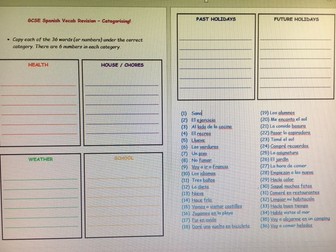GCSE Spanish - 1 Short Foundation Reading Paper and Answers
I have created this practice GCSE Foundation Reading paper, using the same themes and topics as those included in the AQA and Edexcel examinations.
**This paper is shorter than the standard GCSE paper, with 5 questions, totalling 20 marks**
Instructions are included on the front cover and questions are laid out in a similar style to genuine papers. The paper is in font 16, so you can print the papers on A5 for students, saving on photocopying.
Topics included are,
Self and Family
Holidays (past tense)
School
Environment - recycling etc
The Teacher Answers are provided on the final page, so make sure you don't print this with the paper for students!
I have a Higher Tier version that I have just created, but still need to complete the Answer Sheet. It will be uploaded soon.
All images are provided by openclipart.org.
I hope this paper serves as a useful revision and practice tool, for your students, before their exam in a couple of weeks' time.
